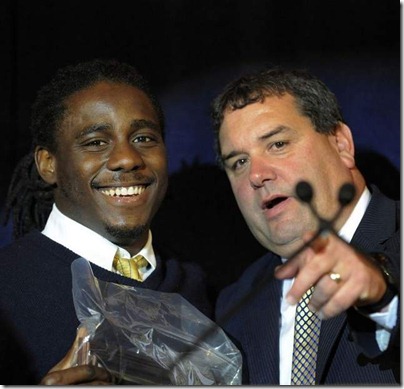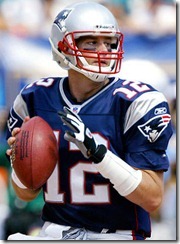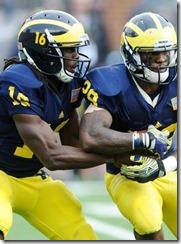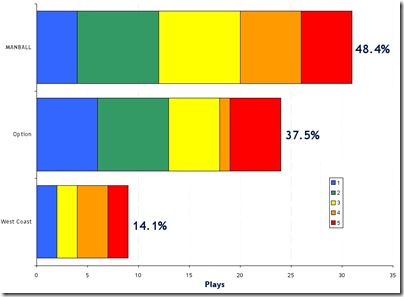Michigan Muse(urs)day Has a Wicked Fastball

MANBALL: BEATING the opponent with POWER running and repetitive CONTACT and MANLY CAPITALIZED WORDS.
West Coast: A symphony of route design and timing that puts defenses into a progression of impossible choices
Option: Isolate an unblocked defender so that he's forced into a Catch 22 decision.
Justin Verlander: A metaphor.
After reading Parts I, II and III of this series you might think a college offense must only be one of these things. That is a very effective thought, as the best offenses in college football according to people who can extricate offense from defense, special teams, winning, fairy dust, and these days seem to center around doing one of these things very well.
But doing one thing well and building around that isn't the only way to build an offense. In fact if you only do your one thing well and can't execute other things, the other team will adjust quickly and now you won't do your one thing well anymore. These were the points made in the previous articles, the first (Doctor Rocklove) to explain the terminology, the second (Rock, Paper, Scissors) to describe constraint theory and demonstrate a Rock/Paper/Scissors for four different philosophies. The third (Pulls Bazooka!) got into the concept of vanilla defense. This last asks the question: what's Michigan's rock?
The Verlander Effect: Doing Multiple Things Well is Good
I'd like to first hone in on how "Rock" is used in this context, since it's not just another cell in an equal triangle matrix.
In honor of Opening Day today I'll use a baseball metaphor. Pitchers, like offenses, usually build a strategy out of a maximizing the effectiveness of one thing they are exceptional at. A 95+ mph 4-seam (ie straight-up) fastball is a common "rock" pitch that will, to a typical batter looking for any kind of pitch, give the most trouble. To keep hitters from sitting on the fastball, the pitchers use slow-speed secondary pitches, for example a curveball and/or changeup. This is the constraint theory at play. But when you break down the pitch selection of a typical Fastball-Curveball-Changeup starting pitcher, you'll notice quickly that the fastball is between 40% and 50% of his pitches. Football offenses function on the same principle: throw the fastball, and mix in curveballs and changeups to keep the  hitters/defense from overreacting to, and thus killing the effectiveness of your heater.
hitters/defense from overreacting to, and thus killing the effectiveness of your heater.
Now to relate this to Michigan's offense. You see, not everyone has the same suite of pitches. Among Tiger starters Doug Fister is the normal fastball-curve-changeup guy, but Max Scherzer and Rick Porcello both use a 2-seam fastball, ie a breaking fastball, as "rock." This pitch will dive downwards and (righty on righty) inwards. The downward motion gets a hitter aiming for the meat of the baseball to hit the top of the ball instead, the spin absorbs some of the power of the stroke, and the result is a lightly hit ground ball. To keep hitters from simply adjusting their aim, the 2-seamer's constraints are a 4-seamer (leading to a pop-up), and a slider, which has a lateral motion opposite that of a 2-seamer.
This brings us to Justin Verlander, the best pitcher in (and MVP of) the American League last year. Justin's "rock" is a killer 4-seam fastball – it has lots of lateral movement and lots of velocity and is a total bitch to hit. In a season between half and two thirds of his pitches will be the fastball. However any MLB hitter who is looking for any fastball will be able to hit it, just as Northwestern defenders can stop a Wisconsin rushing attack if they're looking for it or a I-AA team can...let's not go there. Justin also has a devastating curveball and changeup, both of which will F you up if you're looking for his fastball. Verlander's curveball is like Cam Newton's arm: the constraint is good enough in its own right that you can't beat it unless you're overreacting to it, in which case you're now going to be eaten alive by the fastball and changeup.
In 2010 and 2011, Verlander leapt from being a great young pitcher to undeniably elite. What happened is he developed a 2-seamer game. The two-seamer and the slider arrived in 2010 and now account for about 15% of Justin's pitches.
This is all strategy; the other 90% is execution.
What Does Michigan Do Very Well?
The offense of 2011 at its apex was versus Ohio State. Since the Sugar Bowl strategy became "dear God stay away from the middle" on account of Molk playing gimpy, last year's Game is also the best representative we have so far (other than practice video zoomed into Toussaint's nostril hairs) of the 2012 offense. So let's re-live that game from the perspective of formation, personnel, philosophy, and RPS to get a feel for the current Borgesian ideal.
Remember, personnel is the number of RBs and number of TEs, so 22 is two of each. Subtract the total RBs and TEs from 5 to know the number of receivers. I defined "Value" on this scale: 1: Fail. 2: Got some yards, not what it was supposed to. 3: Did what it was drawn up to do. 4: Did better than it was drawn up to do. 5: Broke open for big yardage/score.
| Ln | Dn | Ds | Formation | Per-son-nel | Play | Philosophy | RPS | Value | Yards |
|---|---|---|---|---|---|---|---|---|---|
| M26 | 1 | 10 | Shotgun | 11 | QB sweep | MANBALL | Rock | 3 | 5 |
| M31 | 2 | 5 | Shotgun | 12 | Zone read belly | Option | Rock | 1 | 0 |
| M31 | 3 | 5 | Shotgun | 10 | Slant | West Coast | Rock | 1 | Inc |
| O47 | 1 | 10 | Split Backs | 21 | Flare screen | West Coast | Scissors | 4 | 6 |
| O41 | 2 | 4 | Shotgun | 20 | Inverted veer keeper | Option | Rock | 5 | 41 |
| M48 | 1 | 10 | Denard Jet | 12 | Jet sweep | MANBALL | Rock | 3 | 5 |
| O47 | 2 | 5 | Ace | 11 | Throwback screen | MANBALL | Scissors | 2 | 2 |
| O45 | 3 | 3 | Shotgun | 11 | QB power | MANBALL | Rock | 2 | 2 |
| O43 | 4 | 1 | I-form | 22 | FB dive | MANBALL | Rock | 4 | 3 |
| O40 | 1 | 10 | Denard Jet | 12 | Counter pitch | MANBALL | Rock | 2 | 3 |
| O37 | 2 | 7 | Shotgun | 12 | Rollout hitch | MANBALL | Paper | 4 | 8 |
| O29 | 1 | 10 | Shotgun | 20 | Inside zone | Option | Rock | 2 | 3 |
| O26 | 2 | 7 | Shotgun | 21 | Post | MANBALL | Paper | 5 | 26 |
| M7 | 1 | 10 | Shotgun | 11 | Zone read dive | Option | Rock | 2 | 2 |
| M9 | 2 | 8 | Shotgun | 11 | Inverted veer keeper | Option | Rock | 1 | 2 |
| M11 | 3 | 6 | Shotgun | 11 | Rollout Sack | MANBALL | Paper | 1 | -4 |
| M20 | 1 | 10 | Shotgun | 10 | Zone read dive | Option | Rock | 2 | 3 |
| M23 | 2 | 7 | Shotgun | 20 | PA scramble | Option | Paper | 2 | 5 |
| M28 | 3 | 2 | Shotgun | 22 | QB power | MANBALL | Rock | 3 | 3 |
| M20 | 1 | 10 | Shotgun | 11 | Zone read keeper | Option | Rock | 1 | 1 |
| M22 | 2 | 9 | Shotgun | 11 | PA TE flat | Option | Paper | 3 | 7 |
| M29 | 3 | 2 | Shotgun | 10 | Scramble | West Coast | Rock | 4 | 9 |
| M38 | 1 | 10 | Shotgun | 11 | Sprint counter | MANBALL | Rock | 5 | 46 |
| O16 | 1 | 10 | Shotgun | 11 | Inverted veer give | Option | Rock | 2 | 2 |
| O14 | 2 | 8 | Ace | 12 | Waggle TE flat | MANBALL | Paper | 2 | 3 |
| O11 | 3 | 5 | Shotgun | 10 | Drag | West Coast | Rock | 3 | 5 |
| O6 | 1 | G | Shotgun | 12 | Zone read dive | Option | Rock | 1 | 0 |
| O6 | 2 | G | Shotgun | 20 | Inverted veer keeper | Option | Rock | 5 | 6 |
| M20 | 1 | 10 | Shotgun | 11 | Inverted veer give | Option | Rock | 4 | 8 |
| M28 | 2 | 2 | Shotgun | 11 | QB power | MANBALL | Rock | 2 | 3 |
| M31 | 1 | 10 | Ace | 11 | Throwback screen | MANBALL | Scissors | 4 | 8 |
| M39 | 2 | 2 | Shotgun | 20 | Inverted veer give | Option | Rock | 3 | 4 |
| M43 | 1 | 10 | Shotgun | 20 | Triple option dive | Option | Rock | 3 | 4 |
| M47 | 2 | 6 | Shotgun | 12 | Triple option keeper | Option | Rock | 3 | 5 |
| O48 | 3 | 1 | Shotgun | 11 | QB power | MANBALL | Rock | 3 | 3 |
| O45 | 1 | 10 | Shotgun | 21 | PA TE seam | Option | Paper | 5 | 26 |
| O19 | 1 | 10 | Shotgun | 11 | QB sweep | MANBALL | Rock | 4 | 6 |
| O13 | 2 | 4 | Shotgun | 12 | Triple option pitch | Option | Rock | 1 | -7 |
| O20 | 3 | 11 | Shotgun | 10 | Dig | West Coast | Rock | 5 | 20 |
| M9 | 1 | 10 | Shotgun | 11 | Sprint counter | MANBALL | Rock | 1 | 1 |
| M10 | 2 | 9 | Shotgun | 11 | QB draw | West Coast | Scissors | 4 | 10 |
| M20 | 1 | 10 | Shotgun | 20 | Inverted veer keeper | Option | Rock | 5 | 22 |
| M42 | 1 | 10 | Shotgun | 20 | Triple option dive | Option | Rock | 2 | 3 |
| M45 | 2 | 7 | Shotgun | 11 | PA rollout out | MANBALL | Paper | 3 | 4 |
| M49 | 3 | 3 | Shotgun | 10 | Corner | West Coast | Rock | 1 | Inc |
| M25 | 1 | 10 | Shotgun | 11 | QB sweep | MANBALL | Rock | 2 | 3 |
| M28 | 2 | 7 | I-form | 21 | Waggle deep out | MANBALL | Paper | 5 | 20 |
| M48 | 1 | 10 | Shotgun | 20 | Zone stretch | Option | Rock | 5 | 11 |
| O41 | 1 | 10 | Shotgun | 11 | QB draw | MANBALL | Scissors | 4 | 10 |
| O31 | 2 | In | I-form | 21 | Power off tackle | MANBALL | Rock | 3 | 5 + 13 Pen |
| M13 | 1 | 10 | Shotgun | 11 | Zone read keeper | Option | Rock | 2 | 3 |
| M10 | 2 | 7 | Shotgun | 11 | Inverted veer keeper | Option | Rock | 3 | 6 |
| M4 | 3 | 1 | Goal Line | 23 | Waggle TE corner | MANBALL | Paper | 3 | 4 |
| M20 | 1 | 10 | I-form | 21 | Sweep | MANBALL | Rock | 2 | 2 |
| M22 | 2 | 8 | Shotgun | 20 | Rollout corner | MANBALL | Paper | 5 | 28 |
| 50 | 1 | 10 | Shotgun | 11 | Zone read dive | Option | Rock | 1 | -1 |
| M49 | 2 | 11 | Shotgun | 10 | QB draw | West Coast | Scissors | 5 | 16 |
| O37 | 1 | 10 | I-form | 21 | Power off tackle | MANBALL | Rock | 5 | 20 |
| O17 | 1 | 10 | I-form | 21 | Power off tackle | MANBALL | Rock | 2 | 2 |
| O15 | 2 | 8 | Shotgun | 11 | QB power | MANBALL | Rock | 4 | 11 |
| O4 | 1 | G | Shotgun | 21 | QB power | MANBALL | Rock | 1 | -1 |
| O5 | 2 | G | Goal Line | 23 | Power off tackle | MANBALL | Rock | 3 | 5 |
| O1 | 3 | G | Goal Line | 23 | Bootleg | MANBALL | Paper | 1 | 1 (pen -25!) |
| O25 | 3 | G | Shotgun | 10 | Throwaway | West Coast | Rock | 1 | Inc |
Non-bullets with charts:
Counting "Denard Jet" as another Ace formation, here's the breakdown:
| Philosophy | Shotgun | Ace | I-form | Split Backs | Goal Line | Total |
|---|---|---|---|---|---|---|
| MANBALL | 17 | 5 | 6 | - | 3 | 31 |
| Option | 24 | - | - | - | - | 24 |
| West Coast | 8 | - | - | 1 | - | 9 |
| Total | 49 | 5 | 6 | 1 | 3 | 64 |
And the breakdown by RPS %:
| Philosophy | Rock | Paper | Scissors | Total |
|---|---|---|---|---|
| MANBALL | 61.3% | 29.0% | 9.7% | 48.4% |
| Option | 87.5% | 12.5% | 0.0%* | 37.5% |
| West Coast | 66.7% | 0.0% | 33.3% | 14.1% |
| Grand Total | 71.9% | 18.8% | 9.4% | - |
As you can see the RPS rolls look more like a Verlander pitch-type tracker than a triangle matrix of equal things. You can also see Borges working in his West Coast game like a 2-seamer/slider tandem. If there was a base play in there it's probably the zone read from a Shotgun 1-back, 1-TE formation, with the blocking switched up (read: "veer"). Borges threw a lot of fastballs, but it worked:
| Philosophy | Rock | Paper | Scissors | Total |
|---|---|---|---|---|
| MANBALL | 2.8 | 3.2 | 3.3 | 3.0 |
| Option | 2.6 | 3.3 | - * | 2.7 |
| West Coast | 2.8 | – | 4.3 | 3.3 |
| Total | 2.7 | 3.3 | 3.8 | 2.9 |
Remember 3.0 on my value scale means the offense was getting that 3rd down conversion, that 5 yards on 1st down, or setting up that 3rd and short every time. Manball accounted for about 72% of plays, and its effectiveness was strong, including many plays that broke big. The corollary of rock's effectiveness was that the constraints all performed better. This offense was working. About the only complaint here is that the Option game was totally missing a constraint. There was one play where Michigan actually faked this constraint—you know what that constraint is—and it was wiiiiide open, but then the play went rock and got stuffed. This is a minor complaint.
----------------------------------------------
* Y U NO BUBBLE SCREENS?
----------------------------------------------
What the hell was this offense?
It was Fastball-Curveball, with some West Coast sprinkled in. Even Rich Rodriguez's Pat White teams would sprinkle in that much pass-first philosophy, because that's another type of changeup you can throw. What we see here though is that the Option-from-Shotgun philosophy and MANBALL-from-mostly-shotgun philosophies are working in tandem. If you recognize this, it's really not all that different than Michigan's offense in 2010. If you have Denard, you run POWER with him, or you use him in a zone read option.
So after all that you're saying Al Borges is running the same offense Rich Rodriguez ran?
Wait, you were the subheads a second ago; when did you become a bolded alter-ego?
Answer the question!
Well no because it was just 75% shotgun versus like 85%, but other than that, yeah, kind of. But it's not Rich Rod's offense (the Zone Read) from West Virginia; it's what RR did when he got Denard. And I might point out that this was against Ohio State, so while I'm using it as a stand-in for the 2012 offense, that's not quite right because Borges has said and shown in other games that he's not going to have Denard run this often. This was Ohio State; this was balls to the wall.
The lesson of the 2011 offense is that Borges believes in all of this stuff, and despite earlier reticence, is happy to take the best of different philosophies and best use his personnel. And he can identify what that is.
 The other thing is how he uses things other than the normal constraint plays as his changeups. Michigan is pitching with a plus-fastball and plus-curveball out of the same "motion," in this case formation. The personnel change on virtually every play, and the changeups are rare and (sometimes) devastatingly effective.
The other thing is how he uses things other than the normal constraint plays as his changeups. Michigan is pitching with a plus-fastball and plus-curveball out of the same "motion," in this case formation. The personnel change on virtually every play, and the changeups are rare and (sometimes) devastatingly effective.
As a 2011 strategy it was frustrating during Iowa to see Michigan come out in an I-form on 1st and 10 in the 1st quarter, and then to hear Borges in the press conference treat questions about that as if we were asking about I-form on 2nd and 2 in the 4th quarter when Michigan's in clock-kill mode. This he learned, as he learned the best way to use Denard is to keep the threat of his legs involved in everything.
So why all the "Power" in the press conferences?
We learned this isn't actually philosophic zeal so much as the fact that one of the key benefits of running power for coaches is getting to say the word "Power" in press conferences. One of the nice things about Power is using the rhetoric, and until the massive incoming linemen and rocket-armed QB and pounding tailbacks and stable of tight ends and tall receivers are on hand to make a Wisconsin offense a reality, these coaches will be happy to take the best of all philosophies and run with them.
Next time in this series (last time?), I'll tackle why recruiting for the Wisconsin offense is perhaps a good idea for the future.
"The lesson of the 2011 offense is that Borges believes in all of this stuff, and despite earlier reticence, is happy to take the best of different philosophies and best use his personnel. And he can identify what that is."
As long as Borges is flexible, and plays to the personnel's strengths and shores up their weaknesses, they'l be in a position to succeed. That's the first job of any coach. I can't wait to see how he'll use those strengths in 2012 and beyond.
Deveon Smith. Ty Isaac. Wyatt Shallman. Two recruiting classes filled with mountain-sized O-linemen. No, power football is not a talking point. Clearly it's part of the transformation of the offense. It isn't "rhetoric."





Comments